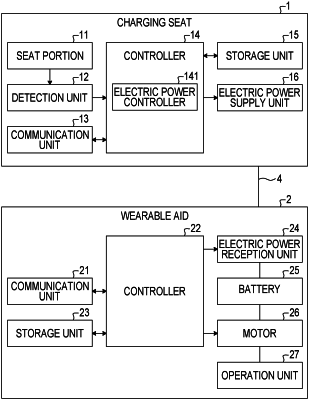| CPC H02J 50/90 (2016.02) [A61H 3/00 (2013.01); H02J 7/00034 (2020.01); H02J 7/0042 (2013.01); H02J 50/10 (2016.02); H02J 50/80 (2016.02); A61H 2003/007 (2013.01); A61H 2201/165 (2013.01)] | 16 Claims |

|
1. A charging seat comprising a processor having hardware, wherein the processor is configured to
detect that a user is seated in a seat portion,
detect an electric assistance apparatus that is worn by the user and assists the user in walking,
identify a charging standard of the electric assistance apparatus through communication with the electric assistance apparatus,
detect that the charging seat is electrically connected to the electric assistance apparatus via a charging cable, and
supply electric power in conformity with the charging standard of the electric assistance apparatus to the electric assistance apparatus.
|